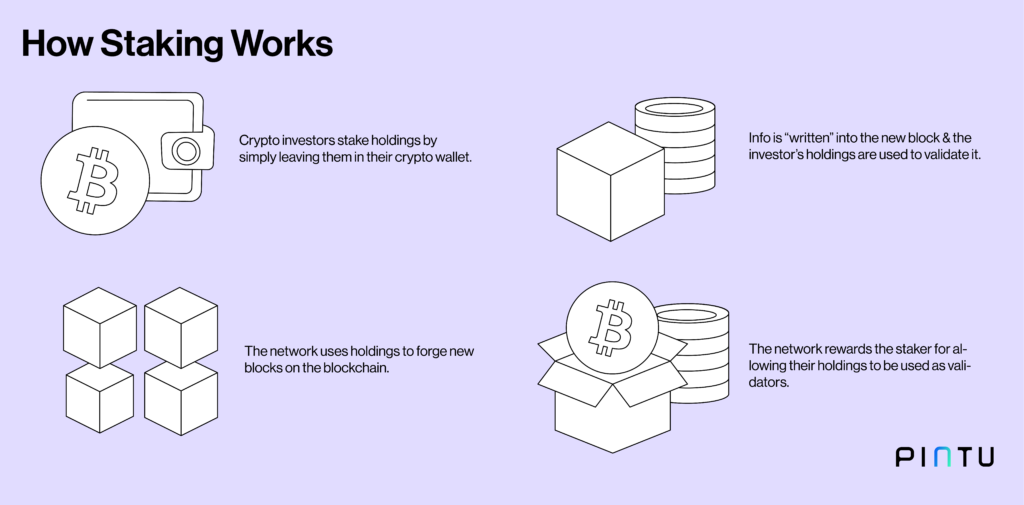

What Is Crypto Staking & How Does It Work?
Staking enables you to earn rewards by allocating your crypto assets to support a blockchain network. By assisting in maintaining its operations and security, you receive additional units of the respective cryptocurrencies you have staked.
Introduction to Crypto Staking
Crypto staking has become a widely adopted method for both cryptocurrency traders and holders to generate passive income while contributing to blockchain network security. By locking their assets within the network, participants assist in transaction validation, enhance blockchain security, and receive rewards in return. This guide covers the fundamentals of crypto staking, its operational mechanisms, advantages, and associated risks. Although TMGM specializes in CFD trading, gaining an understanding of staking provides valuable insights into the broader cryptocurrency ecosystem and supports informed trading strategies.
What is Crypto Staking?

Definition of Crypto Staking
Crypto staking involves cryptocurrency holders committing their digital assets to support a blockchain network and validate transactions. It is a transaction validation method used by cryptocurrencies employing the proof-of-stake (PoS) consensus protocol.
How Crypto Staking Works

The Basics of Crypto Staking
Users lock a portion of their cryptocurrency holdings in a designated wallet.
This staked amount serves as collateral to participate in transaction validation.
Validator (Node) Selection in Staking Networks
The network selects validators (nodes) based on the volume of assets staked.
Generally, the greater the stake, the higher the probability of being chosen to validate transactions.
Transaction Validation Process in Crypto Staking
Selected validators confirm new transactions.
Upon successful validation, a new block is appended to the blockchain ledger.
Reward Distribution in Staking Protocol

Validators earn rewards in the form of additional cryptocurrency tokens.
These rewards are typically proportional to the amount staked.
TMGM Perspective: Although TMGM does not provide direct staking services, understanding this mechanism can assist traders in anticipating price movements in proof-of-stake cryptocurrencies.
Proof-of-Stake vs. Proof-of-Work
Proof-of-Stake (PoS) in Crypto Staking
Utilizes staked assets to validate transactions
More energy-efficient consensus mechanism
Typically enables faster transaction confirmation times
Proof-of-Work (PoW) vs Crypto Staking
Relies on computational power to solve complex cryptographic puzzles
Significantly higher energy consumption
Employed by cryptocurrencies such as Bitcoin
TMGM Offering: TMGM offers CFD trading on both PoS and PoW cryptocurrencies, enabling traders to capitalize on price fluctuations regardless of the underlying consensus protocol.
Benefits of Crypto Staking
Generating Passive Income through Crypto Staking
Staking allows investors to earn passive income by locking digital assets within a blockchain network. Unlike active strategies such as day trading, staking provides rewards without the need to time the market or engage in frequent trading.
Enhancing Network Security via Crypto Staking
Staking is essential for securing proof-of-stake networks. By incentivizing validators to act honestly, it preserves network integrity. This long-term alignment contrasts with spot trading, which focuses on short-term price fluctuations and immediate asset ownership.
Energy Efficiency: Crypto Staking vs. Mining
Proof-of-stake systems consume substantially less energy compared to proof-of-work mining.
Potential for Asset Appreciation While Staked
Staked assets retain the potential to appreciate in value. Traders often use technical analysis tools such as Fibonacci retracementto evaluate long-term growth prospects of staking-related tokens.
TMGM Alternative:
While TMGM does not facilitate direct staking, traders can benefit from price movements of staking-based cryptocurrencies through CFD trading.
Risks and Considerations in Crypto Staking
Volatility Risk in Crypto Staking
The market value of staked assets and staking rewards can experience significant volatility.
Liquidity Risk Associated with Crypto Staking Platforms
Assets committed to staking are usually locked for a defined period, limiting liquidity.
Technical Risks in Staking Protocols
Potential loss of staked funds due to technical failures or network issues
Risk of forfeiting stake if validator node is offline when required
Regulatory Risks in Crypto Staking
Changing regulatory frameworks may affect staking platform operations and taxation of rewards. Staying informed on regulatory developments is crucial to mitigate unexpected impacts on earnings or compliance.
TMGM Risk Management:
When trading cryptocurrency CFDs on TMGM, utilize stop-loss orders and appropriate position sizing to manage risks linked to crypto market volatility.
Popular Cryptocurrencies for Staking
Ethereum 2.0 and the Evolution of Crypto Staking
Transition from proof-of-work to proof-of-stake consensus.
Staking Cardano (ADA) for Passive Rewards
Built on a proof-of-stake protocol from inception.
Staking Polkadot (DOT) via Nominated Proof-of-Stake
Employs a nominated proof-of-stake (NPoS) consensus model.
Staking Tezos (XTZ) on Blockchain Networks
Introduced the concept of "liquid proof-of-stake".
TMGM Trading Opportunities: TMGM offers CFD trading on a variety of cryptocurrencies, including those utilizing proof-of-stake consensus.
Crypto Staking Compared to Other Crypto Strategies
Staking vs. Mining Explained
Staking: Holding and "locking" coins to support network operations
Mining: Employing computational power to solve cryptographic challenges
Staking vs. Yield Farming: Key Distinctions
Staking: Generally simpler with typically lower returns
Yield Farming: More complex, potentially higher yields but with increased risk
Staking vs. Traditional Crypto Trading
Staking: A passive income approach
Trading: An active strategy requiring market analysis and frequent decision-making
TMGM Trading: While TMGM does not provide direct staking or yield farming services, it offers a platform for active trading of cryptocurrency CFDs.
Getting Started with Crypto Staking
Select a Proof-of-Stake Cryptocurrency to Stake
Conduct research on various PoS cryptocurrencies and their staking protocols.
Acquire the Selected Cryptocurrency for Staking
Purchase the cryptocurrency via a reputable exchange.
Choose a Staking Method That Fits Your Needs
Options include:
Exchange-based staking
Wallet staking
Joining a staking pool
Follow the specific procedures for your chosen staking method and cryptocurrency.
TMGM Alternative: If you prefer to capitalize on cryptocurrency price movements without the complexities of staking, consider trading crypto CFDs on TMGM's platform.
The Future of Crypto Staking
Increasing Adoption of Crypto Staking
More cryptocurrencies are transitioning to PoS consensus mechanisms.
Growing Institutional Interest in Staking
Rising participation from institutional investors in staking activities.
Regulatory Developments Impacting Crypto Staking
Evolving regulatory frameworks may influence the staking ecosystem.
TMGM Commitment: TMGM continuously monitors cryptocurrency market trends to deliver current trading opportunities and market insights.
Please remember, while crypto staking can provide rewards, it carries inherent risks. Conduct comprehensive research and assess your financial situation before engaging in cryptocurrency activities. If you prefer trading cryptocurrencies without the complexities of staking, explore TMGM's crypto CFD trading options.
Trade Smarter Today






Account
Account
Instantly





